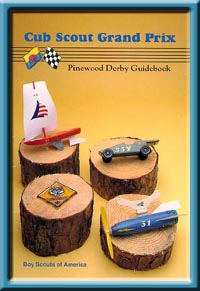|
Getting Started
Step 1. Know the Rules
Read the rules and specifications found in your kit. Also read any rules provided by your local derby committee. Discuss your ideas with your parent or adult partner and determine a plan for the construction of your derby entry.
Racing Specifications from the Kit
- Width.
The overall width of the car shall not exceed 2Y4 inches.
- Length.
The overall length of the car shall not exceed 7 inches.
- Weight.
The weight of the car shall not exceed 5 ounces.
No loose materials of any kind are permitted in the car. The car may be hollowed out and built up to the maximum weight by the addition of wood or metal only, provided any additional material is securely built into the body.
- Wheel bearings
, washers, and bushings are prohibited.
- Springing.
The car shall not ride on any type of springs.
- Details.
Details such as the steering wheel, driver, decals, painting, and interior detail are permissible as long as these details do not exceed the maximum length, width, and weight specifications.
- Attachments.
The car must be freewheeling, with no starting devices.
- Inspection.
Each car must pass inspection by the official inspection committee before it will be allowed to compete. The inspectors have the right to disqualify those cars that do not meet these specifications.
Each local derby committee provides copies of the rules for that specific race. See the example provided.

Example:
Pinewood Derby Rules
- All cars must pass inspection to qualify for the race. The inspection points are as follows:
a. The car must have been made during the current year (the year in which the derby is held).
b. The width of the car shall not exceed 2Y4 inches.
c. The length of the car shalt not exceed 7 inches.
d. The weight of the car shall not exceed 5 ounces.
e. Axles, whecls, and body wood shall be as provided in the kit.
f. Wheel bearings, washers, and bushings are prohibited.
g. The car shall not ride on any kind or type of springs.
h. Any details added must be within length, width, and weight limits.
i. The car must be freewheeling, with no starting devices.
j. No loose materials of any kind (such as lead shot) are allowed in the car.
k. The official number must be clearly marked or visible on both sides of the car.
- Each heat will be announced. Drivers will report to the starting line and place their cars on the track. All other people must remain behind the barrier.
- The starter will make sure the cars are on the track properly and then will start the race.
- The starter and drivers will then report to the finish line to record the results.
- The car whose nose is over the finish line first is the winner. Place spotters will select the first-, second-, third-, and fourth-place winners.
- If a car leaves the track, runs out of its lane, interferes with another car, loses an axle, etc., the heat will be rerun. If the same car gets into trouble on the second run, the contestant is disqualified and automatically loses that race. If, on the second run, another car is interfered with, the heat will be run a third time but without the disqualified car.
- When the results of each heat are recorded, the drivers will take their cars and return to their seats.
- Awards will be announced shortly after the heat for which the awards are to be given. The drivers and their partners will report to the stage for the awards as their names are called.
- There are a total of _________ heats and _________ awards to be given. Den winners will be determined first. The first four places from each den will advance to the pack championship heats. The remaining drivers will participate in consolation heats.
May the best car win!
Suggestion: Modify these rules to fit your needs and furnish a copy to every race participant at the same time he is issued his pinewood derby car kit.
Copyright ©, 1992, Boy Scouts of America, All Rights Reserved
BACK TO TOP
|
![]()
![]()
